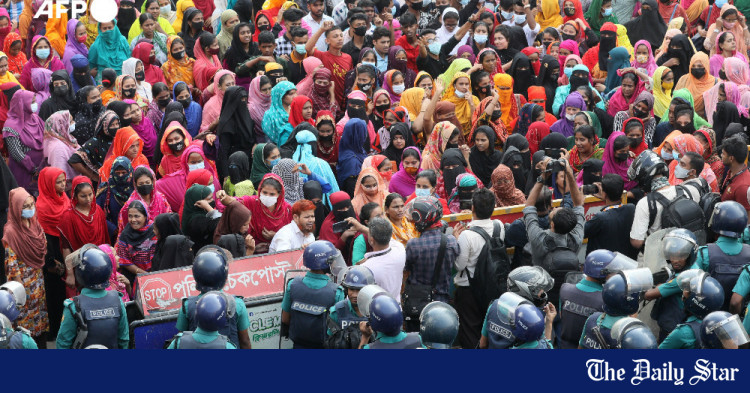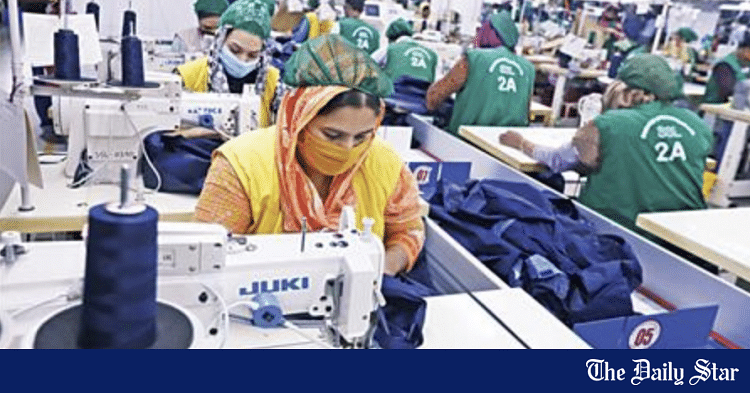- Copy to clipboard
- Thread starter
- #181
Saif
Senior Member
- Jan 24, 2024
- 11,506
- 6,437
- Origin

- Residence

- Axis Group


Collaborative approach needed for RMG sector growth: experts
Experts on Wednesday said that the country needed a collaborative approach from the government and the stakeholders of garments sector to utilise the huge potential of the sector.
 www.newagebd.net
www.newagebd.net
Collaborative approach needed for RMG sector growth: experts
Staff Correspondent 06 November, 2024, 22:27

Civil aviation and tourism ministry secretary Nasreen Jahan as chief guest inaugurates 23rd Bangladesh edition of the Textile Series of Exhibitions hosted by CEMS-Global USA at the Bangladesh-China Friendship Exhibition Centre, Purbachal in Dhaka on Wednesday. Export Promotion Bureau vice-chairman and BGMEA administrator Md Anwar Hossain, BKMEA president Mohammad Hatem and CEMS Global USA and Asia-Pacific president and group managing director Meherun N Islam, among others, were present. | Press release photo
Experts on Wednesday said that the country needed a collaborative approach from the government and the stakeholders of garments sector to utilise the huge potential of the sector.
They made the remark at the inaugural session of the ‘Textile Series of Exhibitions’, organised by New York-based multinational exhibition and convention organiser CEMS-Global USA at the Bangladesh-China Friendship Exhibition Centre at Purbachal in Dhaka.
The Bangladesh edition of CEMS-Global’s Textile Series of Exhibitions features ‘23rd Textech Bangladesh 2024 Expo’ which offers opportunity for industry people to explore the latest innovations in textile production, garment machinery, and related technologies, ‘22nd Dhaka International Yarn and Fabric Show 2024’ which exhibits the collections of yarn, fabric, trims, and accessories, and ‘45th Dye+Chem Bangladesh 2024 International Expo’ which focuses on dyestuff, fine and specialty chemicals.
Export Promotion Bureau vice-president Md Anwar Hossain said, ‘Globally, the total turnover of apparel sector is about $2 trillion, whereas we export only about $40 billion. To utilise the prospects, we need investments as well as policy support from the government.’
Anwar, also the administrator of the Bangladesh Garment Manufacturers and Exporters Association, said, ‘The most challenging thing in front of us is skilled human resources. We need a collaborative initiative on this aspect from the government, business owners and workers of the readymade garments sector.’
Meherun N Islam, president and group managing director of CEMS Global USA & Asia-Pacific, said that these exhibitions were the largest business-to-business meeting place held in Bangladesh for buyers and suppliers, where they could work through direct contact to expand business.
‘As these exhibitions are the largest gathering of foreign and domestic suppliers, buyers and sellers - Bangladeshi businesspeople do not have to go abroad to find buyers or face visa complications, saving money, labour and time,’ she said.
‘Besides, foreign buyers and sellers coming to the exhibition also add a different dimension to Bangladesh’s travel tourism,’ she added.
Nasreen Jahan, secretary of the civil aviation and tourism ministry, said that the government was working alongside the private sector in order to improve the tourism sector in the country.
‘This event is important in terms of unlocking the business prospects in the readymade garments sector, as well as the tourism sector of Bangladesh, as the exhibition brings people from all over the world to this country,’ she said.
Mohammad Hatem, president of the Bangladesh Knitwear Manufacturers and Exporters Association, among others, was present in the programme.
Staff Correspondent 06 November, 2024, 22:27
Civil aviation and tourism ministry secretary Nasreen Jahan as chief guest inaugurates 23rd Bangladesh edition of the Textile Series of Exhibitions hosted by CEMS-Global USA at the Bangladesh-China Friendship Exhibition Centre, Purbachal in Dhaka on Wednesday. Export Promotion Bureau vice-chairman and BGMEA administrator Md Anwar Hossain, BKMEA president Mohammad Hatem and CEMS Global USA and Asia-Pacific president and group managing director Meherun N Islam, among others, were present. | Press release photo
Experts on Wednesday said that the country needed a collaborative approach from the government and the stakeholders of garments sector to utilise the huge potential of the sector.
They made the remark at the inaugural session of the ‘Textile Series of Exhibitions’, organised by New York-based multinational exhibition and convention organiser CEMS-Global USA at the Bangladesh-China Friendship Exhibition Centre at Purbachal in Dhaka.
The Bangladesh edition of CEMS-Global’s Textile Series of Exhibitions features ‘23rd Textech Bangladesh 2024 Expo’ which offers opportunity for industry people to explore the latest innovations in textile production, garment machinery, and related technologies, ‘22nd Dhaka International Yarn and Fabric Show 2024’ which exhibits the collections of yarn, fabric, trims, and accessories, and ‘45th Dye+Chem Bangladesh 2024 International Expo’ which focuses on dyestuff, fine and specialty chemicals.
Export Promotion Bureau vice-president Md Anwar Hossain said, ‘Globally, the total turnover of apparel sector is about $2 trillion, whereas we export only about $40 billion. To utilise the prospects, we need investments as well as policy support from the government.’
Anwar, also the administrator of the Bangladesh Garment Manufacturers and Exporters Association, said, ‘The most challenging thing in front of us is skilled human resources. We need a collaborative initiative on this aspect from the government, business owners and workers of the readymade garments sector.’
Meherun N Islam, president and group managing director of CEMS Global USA & Asia-Pacific, said that these exhibitions were the largest business-to-business meeting place held in Bangladesh for buyers and suppliers, where they could work through direct contact to expand business.
‘As these exhibitions are the largest gathering of foreign and domestic suppliers, buyers and sellers - Bangladeshi businesspeople do not have to go abroad to find buyers or face visa complications, saving money, labour and time,’ she said.
‘Besides, foreign buyers and sellers coming to the exhibition also add a different dimension to Bangladesh’s travel tourism,’ she added.
Nasreen Jahan, secretary of the civil aviation and tourism ministry, said that the government was working alongside the private sector in order to improve the tourism sector in the country.
‘This event is important in terms of unlocking the business prospects in the readymade garments sector, as well as the tourism sector of Bangladesh, as the exhibition brings people from all over the world to this country,’ she said.
Mohammad Hatem, president of the Bangladesh Knitwear Manufacturers and Exporters Association, among others, was present in the programme.













